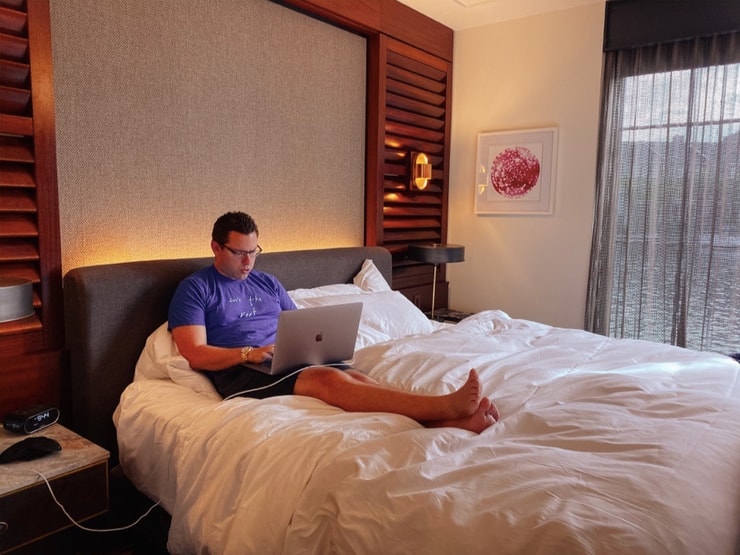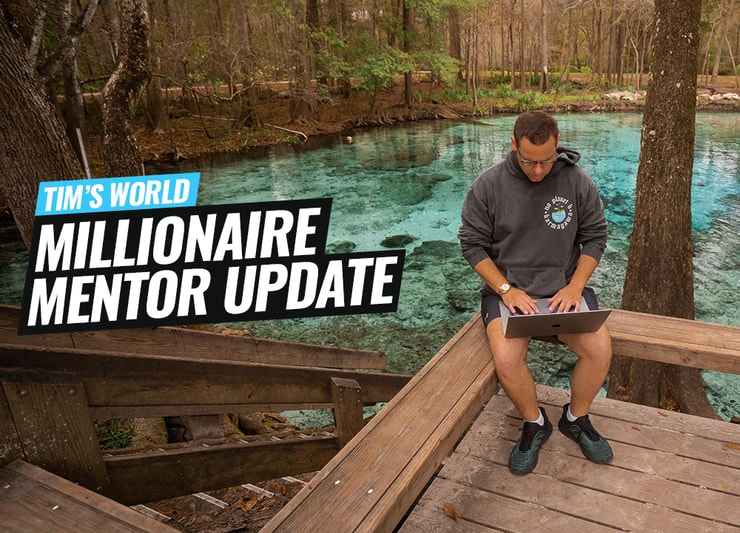There’s a reason all my top students come from the Trading Challenge. It’s because of the interactive learning process.
As a member of the Trading Challenge, you get access to a whole library of educational materials. That includes DVDs, video lessons, and archived webinars. But the key interactive learning elements are live trading webinars and the chat room.
Keep reading for more. First…
Table of Contents
- 1 On the Road Again … With Caution
- 2 Trading Mentor: Interactive Learning Is Key
- 3 New Student Trading Questions
- 3.1 “Why do you short when there’s a gap up?”
- 3.2 “You shared research websites, but the DVD is from 10 years ago and some of them don’t exist. Does StocksToTrade have everything I need?”
- 3.3 “You buy morning panic dumps on the multi-day high pattern, then short the first red day. Aren’t they the same thing?”
- 3.4 “When a stock breaks a certain level, you short. How do you know it isn’t a fake breakdown?”
- 4 Trade of the Week
- 5 Millionaire Mentor Market Wrap
On the Road Again … With Caution
I’m on the move again, but I’m being very careful. Like I said in my last update, the risk versus reward is bad. With the pandemic still going strong, I’m avoiding travel if at all possible.
So why am I on the move? I met up with two amazing millionaire traders. I can’t share full details with you yet, but check out our digs for the weekend…
It’s soooooooooo nice to get out after 6+ months, I made it to Arizona to meet up with 2 amazing millionaire traders: https://t.co/mgClMvf0kh and https://t.co/EuagyXFT44 so I hope you have a great weekend, remember to study a little too! #enjoytheweekend #studyhard #nodaysoff pic.twitter.com/KmnKMaRLtk
— Timothy Sykes (@timothysykes) September 13, 2020
Now I want to explain something important if you want to reach your full potential as a trader.
Trading Mentor: Interactive Learning Is Key
At first glance, it might seem trivial. It’s not. When you see me trade live or participate in webinars with questions, it changes the way you learn. You’re actively involved in the learning process.
By being actively involved, you retain more information. And you gain a certain level of experience. And it’s definitely the best way to get your trading questions answered.
How to Get Your Questions Answered
It’s simple. Join the Trading Challenge and show up to the webinars. Every week I tell Challenge students to come prepared with questions. The best questions come from students who are actively studying.
But there’s one more thing…
Students ask me the same questions over and over. (As you’ll see in the questions to come.) Answers to most questions are in video lessons, DVDs, or “The Complete Penny Stock Course.”
So when students ask questions where they should know the answers, it shows me how little they study. That’s when I go into drill-sergeant mode.
What About Email or DM?
Sorry, I’m so bogged down that I can’t answer emailed trading questions. If I answered all the questions in all the emails I receive, I’d never leave my laptop. For months.
Please do me a favor and ask questions during the Trading Challenge webinars.
That said…
Recently, a brand-new Trading Challenge student emailed some questions. I decided to share my answers here. But just this once. (He now knows to ask during the webinars where the most powerful interactive learning happens.)
New Student Trading Questions
One thing I like about these questions is that it’s clear this student is studying. Keep it up!
More Breaking News
- Quantum Leap: Will MicroCloud Defy the Odds?
- AMC Stock Surge: Balancing on New Debt Strategies
- QuantumScape Stock’s Surprising Ascent
“Why do you short when there’s a gap up?”
Understand that I don’t short sell much these days. A lot of my video lessons are from several years ago when I used to short sell. You have to adapt to what’s working in the market.
Now, I mainly dip buy morning or intra-day panics. Or I buy multi-day breakouts. Those are my patterns.
But it’s good to study what worked in the past. Learn how short sellers think. And recognize there are a lot of short squeezes these days, too.
So, to answer your question…
When I used to short into the gap up, most of them were just BS. The gap ups were due to promoters or misinformation. A recent example of this is…
Caliber Imaging & Diagnostics, Inc (OTCPK: LCDX)
If I was still watchlist in kind. FOR EXAMPLE, a period of deflation might bring more opportunities for short selling, this is the type of play I’d look for.
First, check out the LCDX three-month chart:

LCDX was up from the $1s to the $6s because people thought it was the ticker for Lucid Motors — an electric vehicle (EV) company. The company had to issue this press release. It said, “LCDX shares traded on the OTC have no relation to electric vehicle company Lucid Motors.”
As you can see on the chart, when the company issued the press release the stock tanked. Jack Kellogg and Kyle Williams reported banking on it. So if you’re gonna short, you want to short complete pumps or cases of mistaken identity like this…
Look how beautiful this $LCDX chart is for short sellers, THIS is the kind of play o short with confidence since it's up on people thinking they're an EV play like $TSLA $BLNK $SOLO when they aren't! This is how dumb newbies are in this market, bidding this junk up from $1 to $6+ pic.twitter.com/qMaV1Jy51A
— Timothy Sykes (@timothysykes) August 25, 2020
Again, I don’t short. (I don’t even have the right brokers to short. I use these brokers.) You have to find shares to short sell. Be very careful shorting these days as it’s a crowded and risky strategy.
Yes. Everything has gotten easier with StocksToTrade. I used to search dozens of websites for different research and scans. It’s all built in to StocksToTrade. Use it. It can save you a TON of time. I wish I’d had it in the beginning.
I get similar questions a lot from newbies in the Challenge chat room. It blows my mind when people ask, “How did you find this stock? It doesn’t show up on [insert free website or cheap scanner here.]”
Don’t cheap out on your education or your tools. This is a battlefield. By using a website that doesn’t specialize in low-priced stocks, you’re not giving yourself the best chance. To survive and thrive in battle, you need the best tools.
“You buy morning panic dumps on the multi-day high pattern, then short the first red day. Aren’t they the same thing?”

2025 Millionaire Media, LLCThey are the same pattern, but two different steps in the pattern. So first you want to short the first red day, ideally. If you’re shorting pumps or mistaken identities like LCDX, they usually tank the next day, too. For example, even after LCDX had its big panic, it gapped down the next day.
So, you could short sell the big panic. Then, when it comes down enough, you cover your short to lock in profits. And the panic opens up an opportunity for a potential dip buy.
So, yes, it’s the same pattern. One follows the other.
Learn the seven-step framework in the 30-Day Bootcamp. It also includes the “Pennystocking Framework” DVD as a bonus. Get it.
“When a stock breaks a certain level, you short. How do you know it isn’t a fake breakdown?”
This is another reason I don’t like shorting. First, you need shares to short which often means a specialized broker. Then, even when you do short, it’s risky.
Let’s say it breaks a key level. It could be promoters sucking you in. Or, because there are a lot of other traders short selling at the same time, there might be a fakeout. And then it could break to new highs.
Plus, to short a lot of these plays, you have to be early to even find shares. Which means you gotta risk a little pain. So if it spikes after you short, you have to be willing to take that.
The problem with shorting these days is you never know how far they can go. When I made my short-selling DVDs you might see an extra 10%–30% spike. But now you’re seeing short squeezes that go from $1 to $10. Or even $2 to $50 in two days.
The risk is much greater these days. That said…
Keep Studying Short-Selling DVDs and Video Lessons
You need to understand how short sellers think. Then you can go long on short squeezes. You can ride them all the way up, taking profits along the way.
So it’s good to study the old DVDs and video lessons. Think of it as studying how the enemy thinks…
“If you know the enemy and know yourself, you will not be imperiled in a hundred battles. If you do not know your enemy but know yourself, you will win one and lose one. If you know neither your enemy nor yourself, you will be imperiled in every battle.” — Sun Tzu, The Art of War
Remember, if you want your questions answered, ask during Trading Challenge webinars. That way I can show charts in real time. You can also ask follow-up questions if something isn’t clear. The interactive learning process will speed up your learning curve.
Now for the…
Trade of the Week
This trade was so beautiful. I only wish I’d had a bigger position…
B2Digital, Incorporated (OTCPK: BTDG)
This is the kind of play that someone with a small account should be trading. On September 9, B2Digital announced its new app to deliver live MMA to Apple TV, Amazon Fire Stick, and Android devices.
Here’s the BTDG intraday chart from September 9 with my entry, exit, and the news alert:

This trade was a 75% win for $4,725 in profits.* There was a possible 100% inside of an hour if you were prepared.
(*These results are not typical. Individual results will vary. Most traders lose money. My top students have the benefit of many years of hard work and dedication. Trading is inherently risky. Always do your due diligence and never risk more than you can afford to lose.)
Again, students ask me all the time how I find these stocks. It’s not magic or luck — it’s strategy. I use StocksToTrade for scans and Breaking News Chat for up-to-the-minute news alerts.
Watch this video to see what I mean…
The Two Tools You Need To Help You Find the Top Stocks Every Day
I can’t force you to use the right tools or study. But I want you to see what’s possible when you do. You don’t have to trade big — you can trade small. It’s possible to spot, and trade, the biggest percent gainers in the market.
But you MUST prepare for battle.
Millionaire Mentor Market Wrap
I often say the Trading Challenge is an immersion program. That’s because of the interactive learning that happens. It’s not just about theory. If you’re going to be a successful trader, you MUST implement.
The power is NOT in the idea, it’s in the implementation of the idea. That’s not to say you don’t have to study the video lessons, DVDs, and archived webinars. You do. Mark Croock watched every video lesson three times.
In doing so he grew his knowledge account. Then, he showed up in the chat room every day. He watched the live webinars. He gained experience through interactive learning.
Bottom line: Interactive learning with me and other traders creates the full immersive experience. Experience with the potential to change your life.
Are you ready for a full-immersion, interactive-learning experience? Apply for the Trading Challenge today.
What do you think of interactive learning for penny stock trading? (Hint: this is where you leave a comment because THAT is interactive learning.) Comment below, I love to hear from all my readers!







Leave a reply